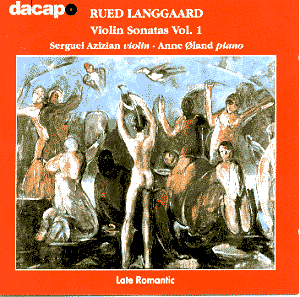Langgaard’s first two violin sonatas date from around
the time of the First World War. The first was composed in 1915 but
revised in 1945 and the second dates from 1920-21. The First
in fact receives its first ever commercial recording in this performance.
It was premiered in Stockholm in 1916 and played again two years later
but whilst it was never again to be performed during the composer’s
lifetime he did revise it quite extensively at the end of the Second
War. It is the revision that is played by Azizian and Øland.
Bendt Viinholt Nielsen’s comprehensive notes explain that the title
Viole was added only during the course of revision and its meaning
is a little obscure. It seems to mean viola though whether Langgaard
ever intended the sonata to be played by the larger instrument is open
to doubt. A compromise seems to be to treat it as a poetic superscription.
In Langgaard it is impossible to ignore the extravagant
movement indications. The earlier sonata is no exception. A Maestoso
fiero espressivo leads on to a fast scherzando followed by a Lento
cogitoso and a decisive finale to be played Molto allegro marcato.
For all the dramatic and committed emphases that these indications
imply this is a work very much in Langgaard’s late Romantic Brahmsian
period. Some strong chordal work by the piano animates the opening movement
(which gave rise to criticism when the composer himself played at the
premiere – one can almost hear the young Langgaard banging out those
chords with unrestrained exultation). There is an ardency and expressive
profile to this movement but also – to be frank – one or two rather
forced transitional passages, musical corners turned with less than
ideal direction and thematic strength. The second movement is a gracious
little waltz that keeps quizzically restarting itself, with some lively
material in the outer sections. The slow movement is quiet and fluent
though not with enough thematic depth to sustain its eight-minute length;
one patch of poor intonation from the violinist here. With the finale
we are back to Brahmsian verities; strength and nicely lyric phraseology
alternate to pleasing but hardly shattering effect. One feels Langgaard
trying out harmonic possibilities in this work as well the potential
for stylistic juxtaposition.
The Second Sonata is a more adventurous and
experimental work, published in 1923 and to an extent influenced by
Nielsen: the notes cite analogues in Ives and Schnittke, both of whom
seem to me misplaced in this work – elements of collage and musical
synthesis seem not as pronounced or insistent here as they are in many
other of his works. The one movement, but obviously sectional, sonata
begins con devozione and this marking, along with Frenetico,
Lento rigoroso and Femminile e virile e con lustro shows
once again the emotional extravagance of Langgaard’s directions. In
fact it’s the violin that starts alone, giving way to a piano statement,
keening rather folk-inflected before some more declamatory writing,
the piano becoming ever more insistent. The Allegro section becomes
increasingly lyrical – with commensurately fine playing from Azizian
and Øland – with occasional saturnine excursions from the pianist
creating the only sense of unease here. I admired the way Serguei Azizian
varied his vibrato usage precisely to mirror emotive peaks and troughs.
After the Frenetico, a second movement in all but name, with
its ancillary tranquillo section a further lament courses
through the third, central section (the sonata is tracked as if in five
movements). It is the Grave section in which the animated but
unsettled nature of the work becomes most apparent – increasing as it
does in pianistic vehemence. A finale then starts utilizing a form of
baroque variational melody, which contrasts with the original folk melody,
and in this contrastive and fruitful way the work ends in something
of a triumphant affirmation. In fact Langgaard uses the medieval tritonus
– the interval called the ‘Devil in Music’ – as a contrastive Romantic
motif; effective without ever quite providing enough muscle to elevate
the work still higher.
Performances are strongly committed and generally assured;
notes good as one expect from Nielsen, who is to Langgaard as Köchel
is to Mozart. Not central Langgaard though – but intimations of future
directions yet to be taken, especially in the case of the second sonata.
Jonathan Woolf

